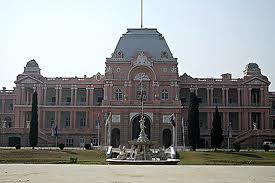Kapurthala
Kapurthala is a small town which is known for its railway coaches manufacturing factory. An average of 1500 coaches is produced per annum. A recent addition was made to the city by setting up Pushpa Gujral Science City.
Rana Kapur founded the city of Kapurthala in the 11th century during the reign of Mahmud of Ghazni. The descendants of Nawab Jassa Singh form the present royal family of the place. The family’s last name Ahluwalia is derived from a village named Ahlu. Nawab Jassa Singh rebelled against the Mughals.
The place has also been referred to as the “Paris of Punjab”. The infrastructure of the place is great. Tourist spots are abundant in Kapurthala.
Places to visit
Sainik School (Jagatjit Palace): Also referred to as the Sainik School, the palace was the abode of Maharaja Jagatjit Singh. French architect M. Marcel designed the place which was completed in the year 1908. It stretches over an area of 200 acres. The prime attraction of the place is Durbar Hall.
Elysee Palace: The Elysee Palace was built in the year 1862 by Kanwar Bikrama Singh. The place is now being used as a school called the MGN School of Kapurthala.
Moorish Mosque: Monsieur M Manteux built this mosque in the year 1930. He was a French architect. This mosque resembles the Qutbya Mosque of Marakesh, Morocco. This forms part of the list of national monument under the Archaeological Survey of India. The designs of the Mayo School of Arts, Lahore are used in the inner dome.
Jagatjit Club: It is a structure that depicts great art work. It has Grecian columns and bell tower. Its designs are inspired from the Acropolis of Athens and feature the Coat of Arms of the then family of Kapurthala. Their royal motto “Pro Rege et Patria” is present on its pediment.
Shalimar Garden: This garden is located in the centre of the town. Royal cenotaphs are found within the garden. The shrines of Maharaja Kharak Singh, Maharaj Jagatjit Singh and Maharaja Paramjit Singh are found in a nearby structure. This structure was built in the 1880. A pond, a park and a library are found inside the garden. A fare on the occasion of Basant Panchmi is organized here every year.
Panch Mandir: Fateh Singh Ahluwalia built this temple. Five other temples surround the main temple. These temples are dedicated to different deities. The construction of this complex is as such that all the five idols can be visible from the entrance gate itself.
The State Gurdwara: This structure was consecrated in the year 1915. It resembles Indo Saracenic style of architecture. Though it is made of sandstone, it is painted white.
Gurdwara Ber Sahib: This gurudwara is built on the place where Guru Nanak spent 14 years of his life. He created “Sukhmani Sahib”. The place got its name from a Ber tree. It is said to have been planted by the guru himself. It is here that he revealed his “Sacred Word or Revelation” of Sikhism.
Pushpa Gujral Science City: This is the biggest project of its kind in north India. It stretches over an area of 72 acres of land. Its purpose is to educate the masse about the wonders of science in a very pleasant and interesting manner.
The War Memorial: It was built in the year 1923. It is made of red sandstone. It resembles Indo Saracenic style of architecture. A bronze statue of a soldier is present here.
The Maharaja's Library: A grand collection of artifacts are exhibited here. Items such as a mechanical clock, a rare orchestra with an automatic tune player, etc. are found here.
Kanjli Wetland: It is located on the outskirts of the city. Bird watching and boating are important activities here.
Mausoleum of Peer Yau-udin Sahib (Peer Chaudhri): The mausoleum of Peer Yau-udin Sahib is situated on the piece of land that was given to him by Maharaja Jagatjit Singh in the year 1902. He was a Muslim Saint. He was the benefactor of the Royal House of Kapurthala.
Sultanpur Lodhi: Numerous gurudwaras are found here which reflect upon the light of Guru Nanak Dev Ji.
How to reach Kapurthala
By Air: The nearest airport is situated at Amritsar. It is located 75 kilometers away. It connects Punjab with the major cities of India.
By Rail: Kapurthala has its own railway stations but the frequency of the trains is low.
By Road:
Important places like Jammu, Shimla, Jalandhar, Ludhiana, Chandigarh, Dehradun, Rajasthan and Delhi are well connected to Kapurthala by road. Both private and government owned buses run from the city, connecting it to different parts of the country. Taxis and autos run within the city.





